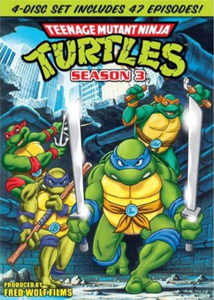In 1989, “Teenage Mutant Ninja Turtles” Inc. went into high gear cranking out product. Season 3 of the cartoon numbers 47 (!) episodes so it could get to a total of 65 and be widely syndicated ahead of the 1990 movie.
The fast pace (which the writers and animators were accustomed to from Seasons 1 and 2) meant formulas had to be locked in. For episodes 1-8, the Technodrome is trapped at the Earth’s core. Shredder and Krang devise one-episode schemes involving wacko tech to get the Technodrome moving or to rule the world or to dispatch the Turtles (or all three).
Even so, the continuity is messy, as the Turtles are surprised by the existence of the Technodrome’s transport modules multiple times. It would be released as a toy in 1990. The excellent website TMNT Entity rearranges these episodes in chronological order partly based on the Turtles’ level of surprise (or, alternately, total lack of comment) over the modules.

“Teenage Mutant Ninja Turtles” Season 3, episodes 1-8 (1989)
Syndicated
Episodes: “Beneath These Streets” (1), “Turtles on Trial” (2), “Attack of the 50-Foot Irma” (3), “The Maltese Hamster” (4), “Sky Turtles” (5), “The Old Switcheroo” (6), “Burne’s Blues” (7), “The Fifth Turtle” (8)
Producer: Fred Wolf
Writers: Michael Reaves (1, 2, 6), Rowby Green (3), David Wise (4), Reed Shelly and Bruce Shelly (5), Bill Wolf and Gordon Bressack (7), Francis Moss (8)
Finding their voices
The voice performances – and therefore the comedy-leaning tone — get nailed down here. Peter Renaday (Splinter), Renae Jacobs (April) and Jennifer Darling (Irma) are my favorites, as they keep the show reasonably grounded. Going over the top are Cam Clarke, whose Leo is extremely earnest and whose Rocksteady is uber-whiny; and James Avery, whose Shredder is perpetually peeved. I wish Rob Paulson’s Raph had a setting other than sarcastic.
Finding a middle ground of light amusement are Pat Fraley (Krang) and Barry Gordon (Donatello and Bebop). Townsend Coleman’s extreme surfer-dude Michaelangelo somehow works for me, as does the broad farce of Fraley’s Burne and Renaday’s Vernon.
Accepting the repetitiveness of Shredder’s schemes and the fact that the writers crib every premise from pop culture, this batch boasts creative episodes. Series creator David Wise returns for “The Maltese Hamster” (4), in which Donatello narrates the “Maltese Falcon” parody in noir voiceover style – except he does it amid the action, rather than in voiceover. This is dumb, but also awesome. (To this day, when saying the name of the Dashiell Hammett novel, I pause and make sure to say “Falcon” instead of “Hamster.”)

It’s also odd that the noir nerd is Don (Mikey is the impersonator in the films), but I like seeing his goofy side. And it inspired the 1990 action figure Don the Undercover Turtle.
Parodies and lessons
Another strong parody is Michael Reaves’ “Turtles on Trial” (2), which adults recognized as being drawn from Morton Downey Jr., a confrontational ratings-grabbing talk-show host whose tactics were even more repulsive than today’s typical screeching pundit. As stirred up by Channel Six’s Clayton Kellerman, the citizenry is anti-Turtle.
For some reason, more money and/or talent goes into the animation of “Trial,” leading to awesome moments of flying shuriken, Don’s hurled bo staff tripping a thug, Leo pulling a sewer cover over his head in a quick getaway, and Turtles moving directly toward the camera in action mode. If every episode was animated and edited with such verve, “TMNT” 1987’s reputation would be vastly better.
In “Trial,” the Turtles are public enemy No. 1, and an anti-Turtle task force pops up (and quickly disappears) in Season 2’s “Invasion of the Punk Frogs,” but generally the populace is indifferent toward them. In some circles, they are worshiped: See celebrity-hound Irma, and also 14-year-old Zach in Francis Moss’ “The Fifth Turtle” (8).
Wearing a homemade mask and shell (perhaps the progenitor of the toy line’s Storage Shells, which debuted in 1990 with Don), Zach is a stand-in for every kid who religiously tuned in to “TMNT” on weekday afternoons. I love the way the Turtles and Splinter welcome him as a friend and hang out with him for a day. Some folks rank this as an elite episode, and I can see why.
It’s easy to forget that the Turtles themselves are barely older than Zach, but Reaves’ rather bland “Beneath These Streets” (1) does feature a lesson about responsibility. The Turtles go to a midnight movie rather than patrolling. They turn off their Turtle-Coms in a precursor to turning off cellphones, and bad things ensue while they are out of contact.
Comedy that (mostly) connects
While “Fifth Turtle” and “Beneath” are fairly serious, comedy is king in this batch. My favorite is Reaves’ “Freaky Friday” riff “The Old Switcheroo” (6), although the reasons for my chuckles are unintended. I love how over-the-top Avery and Renaday are in emphasizing Splinter’s kindness (in Shredder’s body) and Shredder’s nastiness (in Splinter’s body). The perpetually scowling faux-Splinter (joined by dark music) is highly amusing. As a kid, I remember this episode being ominous – with Shredder right there in the Turtles’ lair – and now I love it for its bluntness.
I also enjoy the obvious gags of “Attack of the 50-Foot Irma” (3). A tip of the cap must go writer Rowby Green for passing on the obvious candidate for enlargement (April as a stand-in for Allison Hayes from “Attack of the 50 Foot Woman”) and going with the clutzy, insecure Irma.
“Sky Turtles” (5) – written by Reed and Bruce Shelly (surprisingly, those aren’t “TMNT”-specific pen names) – features absurd misunderstandings of science (gravity in this case), even by this show’s standards. But it does feature a great gag wherein the Turtles knock out Rocksteady by giving him a whiff of his own sock.
Bill Wolf’s and Gordon Bressack’s “Burne’s Blues” (7) goes full-bore into the absurd, with a running gag of Burne and Vernon being captured by mobsters and “tortured” with feathers tickling their toes. This broad parody of tabloid-newspaper tropes culminates in the newsmen being abducted by aliens who resemble Elvis!
“Blues” stood out in my mind for featuring the S&K air conditioning company, a front for the villains. In contrast to “Switcheroo’s” pounded-home reminders about the body-switching, this episode trusts kids to figure out what S&K stands for on their own.
While the multi-tiered bumbling of Bebop and Rocksteady (idiots in Shredder’s eyes) and Shredder (an idiot in Krang’s eyes) and Krang (not as sharp as he could be, in a viewer’s eyes) is amusing, it’d be nice to get a break from it. The writers might’ve been thinking the same thing. Kicking off my next batch of reviews will be the very first episode to not feature Shredder. Stay tuned.

